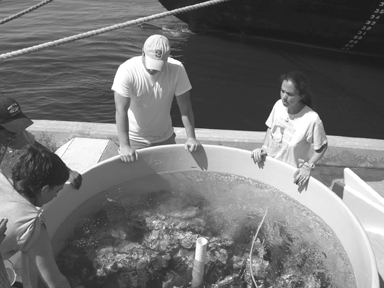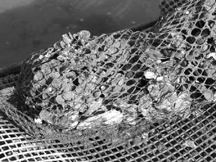
|
Enhancing
Cape Cod Oyster Populations Using Remote Set Technology Off the landing at Scudder's Lane in Barnstable, Mass., low tide has exposed the usual cast of characters: periwinkles, oyster drills, quahogs, razor clams, oysters, and green, mud, hermit and Asian shore crabs. But these mudflats also reveal a curiosity not found in any field guide: racks of shallow, rectangular cages, anchored by steel legs to the muddy bottom. They sit, adorned with sea lettuce and barnacles, waiting for high tide. The cages are part of Barnstable's oyster remote set project, initiated in 1997 as an experiment. The term "remote set" describes oysters that have been reared in tanks, attached to material put in the tanks, and then moved to another location. It is a decades-old technique that has been used mostly for restoration efforts, for which quantity is more important than appearance: remote set oysters tend to cluster together, making them less attractive than the single oysters preferred by consumers, restaurateurs, and private growers.
Marcotti's efforts, assisted by the Southeastern Massachusetts Aquaculture Center (SEMAC), got the attention of shellfish constables in other Cape Cod towns, as well as folks at Barnstable County Cooperative Extension (BCCE) and Woods Hole Sea Grant (WHSG), who initiated a Cape-wide pilot project utilizing remote set technology three years ago. Bill Walton, fisheries and aquaculture specialist for WHSG and BCCE, along with Diane Murphy, a Barnstable County marine extension agent, run the program that was started by Dale Leavitt, former WHSG extension leader. In 2003, nine of Cape Cod's 15 towns are participating. The project is designed to increase town oyster populations, establish a suitable habitat for future populations, and boost the towns' supply of harvestable oysters. Long before cages and mudflats enter the picture, this story begins in two shellfish hatcheries, located at opposite ends of the Cape. At the Buzzards Bay hatchery of the Massachusetts Maritime Academy (MMA), tucked in next to the Academy's training ship Enterprise on the Cape Cod Canal, manager Beth Walton oversees the first and most critical phases of the remote set project: spawning brood stock oysters, raising the larvae, and transferring the larvae to tanks stocked with cultch (shells, rock, or other hard substrate) to which the larvae will attach. Ditto on the other end of the Cape, where Eastham Director of Natural Resources, Henry Lind, tends to his oysters. Whereas Walton oversees the spawning and setting phases before turning the oysters over to the towns for grow-out, Lind keeps his oysters well into the grow-out phase (usually October), before parceling them out to towns. At the MMA hatchery, Beth Walton's trained eye can spot oyster larvae, or "spat," on clam shell fragments, but she's encountered many a doubting look from shellfish constables who come to pick up their cultch bags. She knows they are there, not just because she can see them, but for what she can't see in the tanks: algae. Oysters eat phytoplanktonóand lots of it, says Walton, who cultures a variety of algae onsite in the hatchery's greenhouse.
Once the MMA oysters have set, they are ready to be transported to towns for grow-out. Oysters at MMA have been grown for Barnstable, Bourne, Brewster, Dennis, Yarmouth, and Wellfleet. Lind's hatchery in Eastham will supply oysters to Provincetown and Truro (jointly), Chatham, Eastham, and Harwich. Conrad Caia, shellfish constable in Yarmouth, received 100 bags of oysters in early July. He chose the north side of Grays Beach, inside Chase Garden Creek off Cape Cod Bay, for his oysters. "It's a high energy zone; the current rips through there. But I want to see if I can get them to grow there," he says. The alternativeóthe south side of Grays Beachóhas its share of problems, from water quality to dermo, an oyster disease that can wipe out large portions of a population. "Eventually," says Caia, "I'll put them where the current isn't so strong. Otherwise, I could be putting the harvesters in danger." Caia estimates that since he put the bags in the water, he's spent just a few hours tending them. The next step, splitting up the bags and placing the oysters into cages, will take more time: Caia estimates a couple of days for labor, monitoring, and patrolling the area. He predicts that the final phase, during cold weather season, will be most labor intensive: breaking down the cages and planting the oysters off the beach. If the pilot project succeeds in Yarmouth, Caia would like to continue and possibly expand the program. "I'd like to try and spark something here. We've got no intertidal zone and only two areas open to harvesting right now," he says. Currently there are no wild oysters in Yarmouth, though Caia says there was a wild fishery several years ago. Knowing what to expect from the project is hard, says Caia, because it's his first time growing oysters in the wild. But the uncertainty doesn't keep him from thinking big: he'd like, one day, to produce an oyster reef that replenishes itself and sustains the recreational fishery in Yarmouth. "Maybe it's just a pipe dream," he says, "but that's what I'd like to see." Barnstable's Marcotti is pleased that other Cape towns are giving oysters a try. "It's a fantastic way for towns to bring back the oyster fishery to what it might have been. When we had our pilot study back in '97, we put the oysters out, opened the area to harvest, and saw how excited people were to harvest oysters where they hadn't been before." By the end of the third growing season, Marcotti says between 90‚100 percent of the oysters he'd planted were harvestable. "We had so many oysters to harvest that you could go along and pick the prettiest onesówhatever hit your fancy that day." In Eastham, Lind is encouraged by the feedback he's getting. "This has presented itself as a way to provide training to folks interested in shellfish and aquaculture, while testing a concept that the Barnstable County shellfish officers have been considering for a long time: is it prudent to have a municipally- or county-operated shellfish hatchery to supply the Cape towns with seed?" Competition with commercial shellfish hatcheries was one concern, says Lind. But because most local hatcheries are producing quahog seed, oysters provide a compromise. One exception is Aquacultural Research Corporation (ARC) in Dennis, a private hatchery. But ARC has partnered with Barnstable's Marcotti, who, this year, received funding to expand his program. The grant allowed him to purchase 1,000 bags of oysters from ARC, owned and operated by Barnstable resident Dick Kraus. "Collaboration between the private and public sectors makes perfect sense to me," he says. "You can contribute to private economic gain and supply jobs, while at the same time, the public benefits." Such partnerships are possible for other towns, says Walton. "Our hope is that this project will allow towns to decide if remote set is a method that works for them, as it has in Barnstable. Ultimately," he says, "towns may turn to private hatcheries to supply remote set on a larger scale." Not only is that good for both the public and private sectors, "it means a lot more oysters for Cape waters." |

